

Golang协程调度
source link: https://vearne.cc/archives/39668
Go to the source link to view the article. You can view the picture content, updated content and better typesetting reading experience. If the link is broken, please click the button below to view the snapshot at that time.

版权声明 本站原创文章 由 萌叔 发表
转载请注明 萌叔 | http://vearne.cc
本文基于go1.17.6
1.什么是协程?
协程,英文Coroutines,是一种基于线程之上,但又比线程更加轻量级的存在,这种由程序员自己写程序来管理的轻量级线程叫做『用户空间线程』,
具有对内核来说不可见的特性。
1.1 协程的特点
- 线程的切换由操作系统负责调度,协程由用户自己进行调度
- 线程的默认Stack大小是MB级别,而协程更轻量,接近KB级别。
- 在同一个线程上的多个协程,访问某些资源可以不需要锁
- 适用于被阻塞的,且需要大量并发的场景。
1.2 Golang的GMP模型
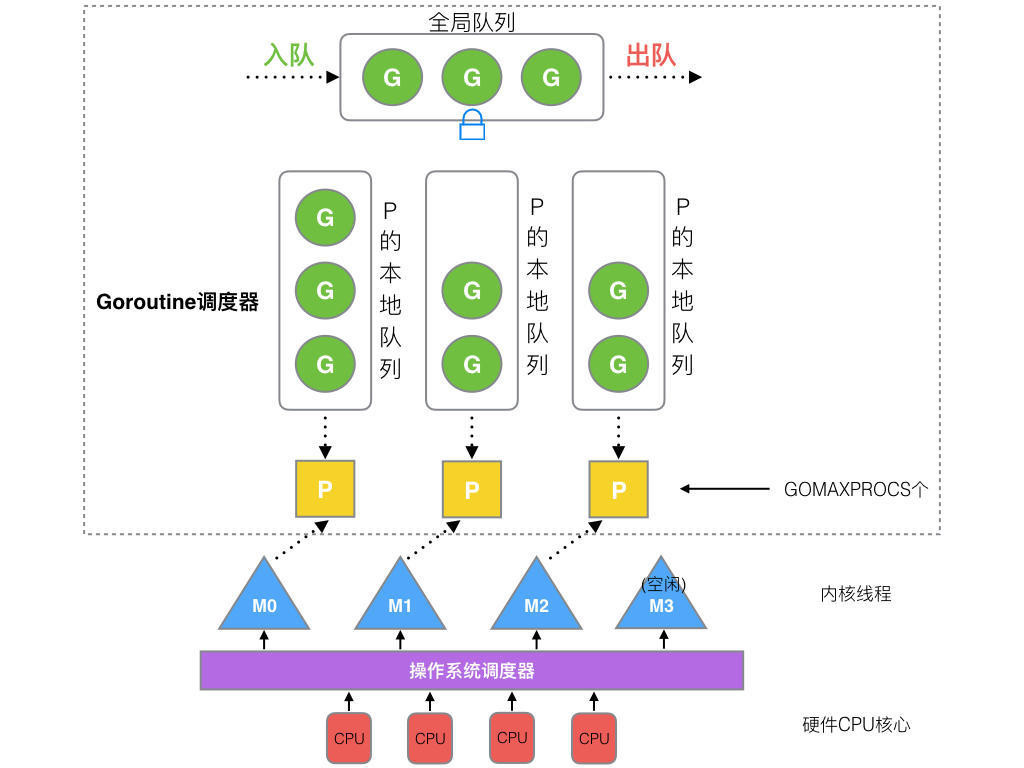
- CPU驱动线程上的任务执行
- 线程由操作系统内核进行调度,Goroutine由Golang运行时(runtime)进行调度
- P的
local runnable queue是无锁的,global runnable queue是有锁的 - P的
local runnable queue长度限制为256
注意:
-
- M和P是绑定关系
-
- M和G是绑定关系
-
- P只是暂存G,他们之间不是绑定关系
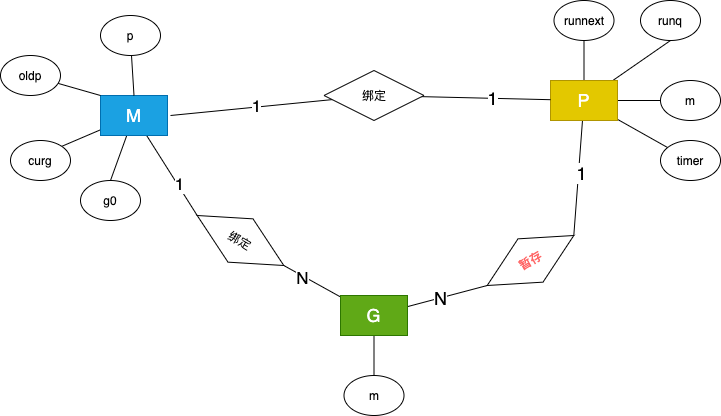
简化后的E-R图
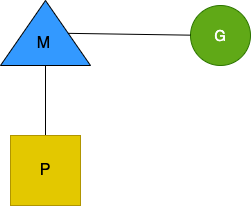
注意: 后面为了书写简单直接将
local runnable queue表示为本地队列global runnable queue表示为全局队列
timer的四叉堆和内存分配器使用的mcache也是每个P一个
Q: 为什么默认情况下P的数量与CPU数量一致?
这样可以避免把CPU时间浪费在上线文切换上
1.3 协程和线程的资源消耗对比
| 类别 | 栈内存 | 上下文切换 | 备注 |
|---|---|---|---|
| Thread | 1MB | 1us | 内存占用使用的是Java线程的默认栈大小 |
| Goroutine | 4KB | 0.2us | 内存占用使用的是Linux+x86下的栈大小 |
2. 常见的Goroutine 让出/调度/抢占场景
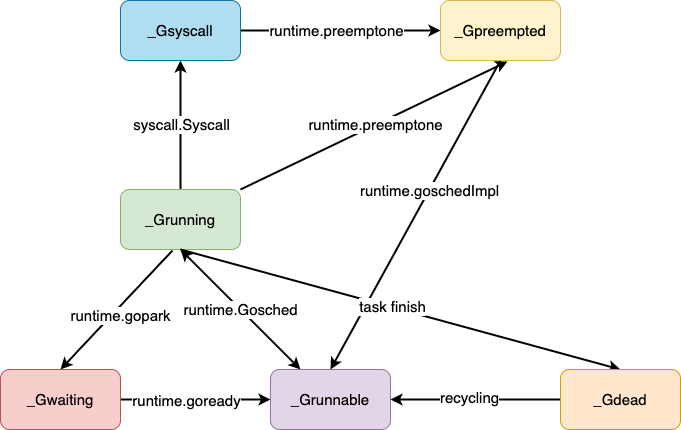
2.1 协程被创建
- 1)P的本地队列有剩余空间时,放入P的本地队列
- 2)P的本地队列没有剩余空间时,将本地队列的一部分Goroutine以及待加入的Goroutine添加到全局队列
2.2 主动让出
2.2.1 使用runtime.Gosched
package main
import (
"fmt"
"runtime"
)
func main() {
runtime.GOMAXPROCS(1)
for i := 0; i < 100; i++ {
fmt.Println("Goroutine1:", i)
//time.Sleep(500 * time.Millisecond)
if i == 5 {
go func() {
for i := 0; i < 100; i++ {
fmt.Println("Goroutine2:", i)
//time.Sleep(500 * time.Millisecond)
}
}()
runtime.Gosched()
}
}
}
具体执行流程
1.Gosched() -> 2.mcall(fn func(*g)) -> 3.gosched_m(gp *g) ->
4.goschedImpl(gp *g) -> dropg()
globrunqput()
schedule()
step2 mcall(fn func(*g))
mcall函数是通过汇编实现的,
在 asm_amd64.s 中
- 1)保存当前goroutine的状态(PC/SP)到g->sched中,方便下次调度;
- 2)切换到m->g0的栈;
- 3)然后g0的堆栈上调用fn;
注意:每个m上都有一个自己g0,仅用于调度,不指向任何可执行的函数
mcall returns to the original goroutine g later, when g has been rescheduled.
fn must not return at all; typically it ends by calling schedule, to let the m
run other goroutines.
step4 goschedImpl(gp *g)
- 1)修改Goroutine的状态 _Grunning -> _Grunnable
- 2)dropg() 将G和M解绑
- 3)globrunqput(gp) 将G放入全局runnable队列
- 4)schedule()
进行一轮调度,寻找一个runnable的G,并执行它,函数不会返回
step4-4 schedule()
schedule() –> 1.findrunnable()
2.execute() –>gogo()
step4-4 schedule() –> findrunnable()
- 1)从同一个P的本地runnable队列中
- 2)从全局的runnable队列中
- 3)从网络轮训器(netpoll)中,是否有事件就绪的G
- 4)通过runtime.runqsteal从其它P的本地runnable队列偷取一半G放入本地runnable队列,并取出一个用来执行
gogo()
汇编实现,用于恢复现场(PC/SP),运行上一步找到的新的可运行的G
Q:为什么一定要单独设置一个g0来执行goschedImpl(gp *g)
A: schedule()会将G的stack搞乱
另外有些文章说g0的栈会使用操作系统分配的线程栈,但是根据萌叔的研究,这个与操作系统有关的。
macOS是使用的线程栈(8MB),但是linux下g0的栈初始大小只有8KB。
runtime/proc.go
// In case of cgo or Solaris or illumos or Darwin, pthread_create will make us a stack.
// Windows and Plan 9 will layout sched stack on OS stack.
if iscgo || mStackIsSystemAllocated() {
mp.g0 = malg(-1)
} else {
mp.g0 = malg(8192 * sys.StackGuardMultiplier)
}
// mStackIsSystemAllocated indicates whether this runtime starts on a
// system-allocated stack.
func mStackIsSystemAllocated() bool {
switch GOOS {
case "aix", "darwin", "plan9", "illumos", "ios", "solaris", "windows":
return true
case "openbsd":
switch GOARCH {
case "386", "amd64", "arm", "arm64":
return true
}
}
return false
}
2.2.2 任务执行完毕
goexit1() -> mcall(fn func(*g)) -> goexit0(gp *g)
// goexit continuation on g0.
func goexit0(gp *g) {
_g_ := getg()
casgstatus(gp, _Grunning, _Gdead)
gp.m = nil
dropg()
gfput(_g_.m.p.ptr(), gp)
schedule()
}
- 1)修改G的状态 _Grunning -> _Gdead
- 2)解除G和M的绑定关系
- 3)将G放入P的空闲G的链表(gfree list)
- 4)触发一轮调度
2.3 抢占式调度
抢占式调度是由守护进程 sysmon() 触发的
sysmon()是一个特殊的m,它不需要和P进行绑定。
func sysmon() {
for{
// 1. 运行计时器
// 2. 检查网络轮询器(netpoll)
// 3. 触发抢占式调度
// 4. 触发GC
}
}
最大时间片是10ms
推荐观看 幼麟实验室的视频
2.3.1 基于协作的抢占式调度
依赖栈增长监测代码
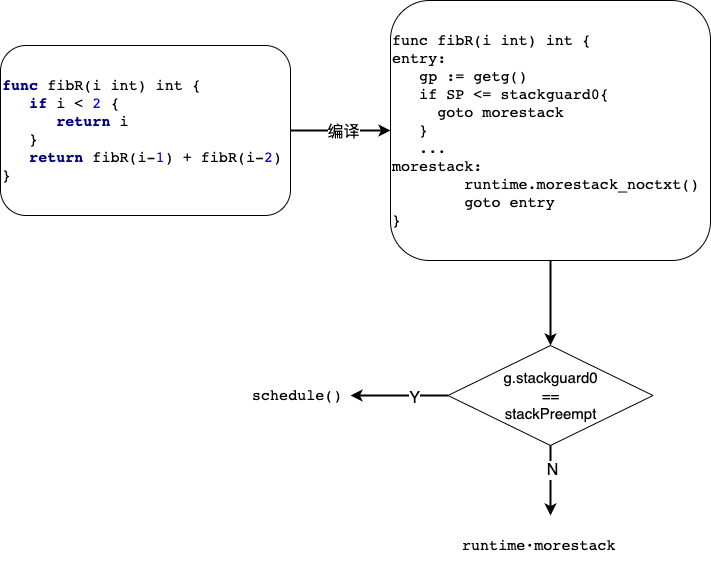
sysmon() -> retake() -> preemptone()
type g struct {
stackguard0 uintptr // offset known to liblink
preempt bool // preemption signal, duplicates stackguard0 = stackpreempt
}
2.3.2 基于信号的抢占式调度
sysmon() -> retake() -> preemptone() -> signalM(mp, sigPreempt)
func preemptone(_p_ *p) bool {
mp := _p_.m.ptr()
if mp == nil || mp == getg().m {
return false
}
gp := mp.curg
if gp == nil || gp == mp.g0 {
return false
}
gp.preempt = true
// Every call in a goroutine checks for stack overflow by
// comparing the current stack pointer to gp->stackguard0.
// Setting gp->stackguard0 to StackPreempt folds
// preemption into the normal stack overflow check.
gp.stackguard0 = stackPreempt
// Request an async preemption of this P.
if preemptMSupported && debug.asyncpreemptoff == 0 {
_p_.preempt = true
preemptM(mp)
}
return true
}
接收到信号
sighandler() -> doSigPreempt() -> asyncPreempt()-> globalrunqput()
asyncPreempt由汇编实现 preempt_amd64.s
2.4 hand off p
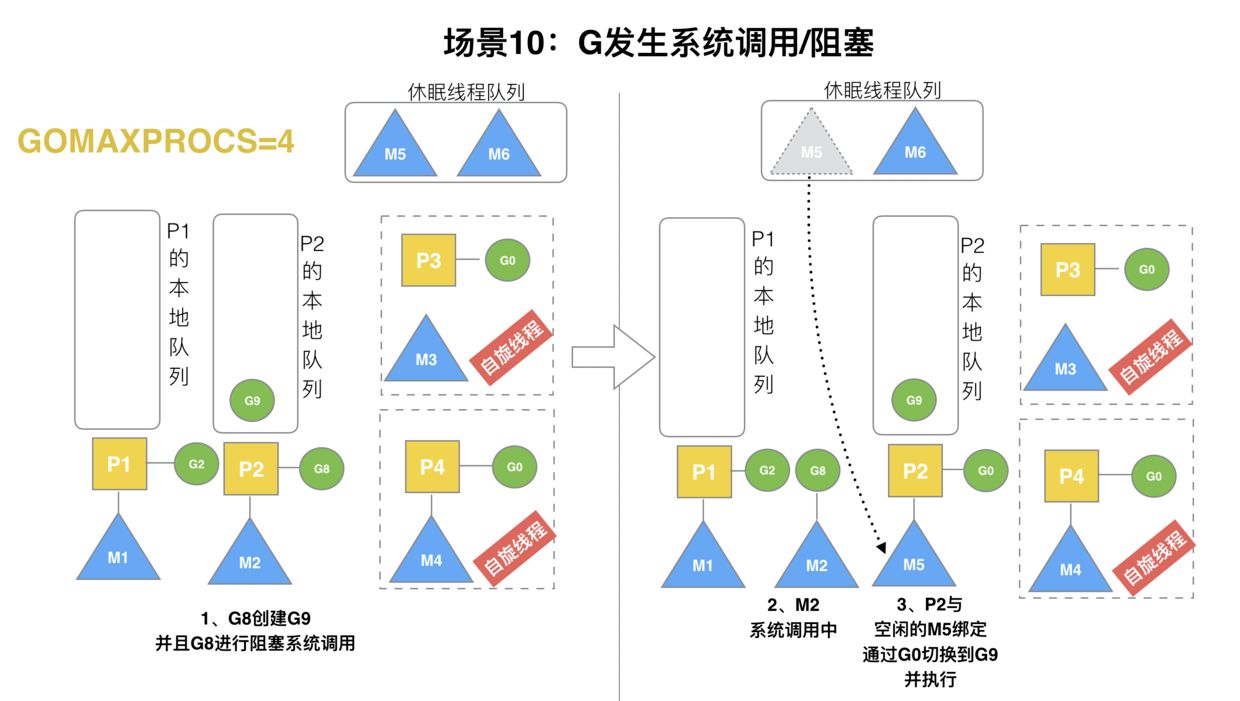
场景读写磁盘文件
涉及syscall.Syscall()
- 由于handeroff机制的存在,读写磁盘文件的过程中,如果IO的压力过大可能会导致大量的系统线程被创建
- 在Golang中(Linux平台),读写网络连接是非阻塞式系统调用,并且是边缘触发
- 在Golang中(Linux平台),读写磁盘文件是阻塞式系统调用
File.Read() -> poll.FD.Read() -> syscall.Read() -> syscall.Syscall()
// Read implements io.Reader.
func (fd *FD) Read(p []byte) (int, error) {
...
for {
n, err := ignoringEINTRIO(syscall.Read, fd.Sysfd, p) // 执行syscall
if err != nil {
n = 0
if err == syscall.EAGAIN && fd.pd.pollable() {
if err = fd.pd.waitRead(fd.isFile); err == nil { // gopark
continue
}
}
}
err = fd.eofError(n, err)
return n, err
}
}
func read(fd int, p []byte) (n int, err error) {
var _p0 unsafe.Pointer
if len(p) > 0 {
_p0 = unsafe.Pointer(&p[0])
} else {
_p0 = unsafe.Pointer(&_zero)
}
r0, _, e1 := Syscall(SYS_READ, uintptr(fd), uintptr(_p0), uintptr(len(p)))
n = int(r0)
if e1 != 0 {
err = errnoErr(e1)
}
return
}
Syscall和RawSyscall的源码
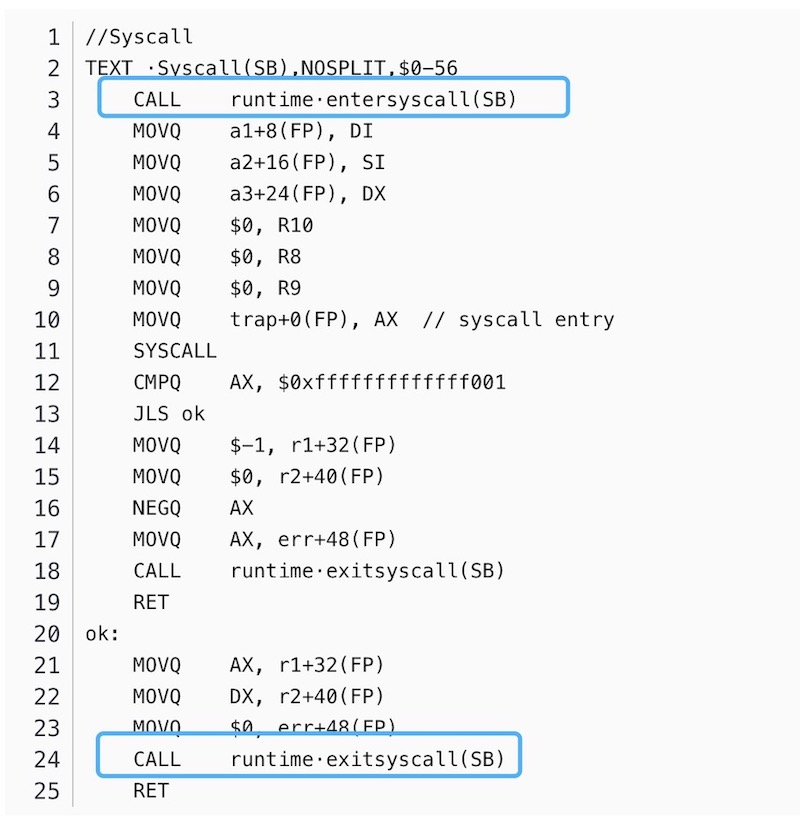
2.4.1 entersyscall()
1.设置_g_.m.locks++,禁止g被强占
2.设置_g_.stackguard0 = stackPreempt,禁止调用任何会导致栈增长/分裂的函数
3.保存现场,在 syscall 之后会依据这些数据恢复现场
4.更新G的状态为_Gsyscall
5.释放局部调度器P:解绑P与M的关系;
6.更新P状态为_Psyscall
7.g.m.locks–解除禁止强占。
进入系统调用的goroutine会阻塞,导致内核M会阻塞。此时P会被剥离掉, 所以P可以继续去获取其余的空闲M执行其余的goroutine。
2.4.2 阻塞式系统调用长期运行将会导致的流程
sysmon() -> retake() -> handoffp()
如果P的本地队列不为空,handoffp()会尝试获取一个M来运行P
M有2种来源:
- 1)
midle: idle m’s waiting for work - 2)newm() 创建一个新M
2.4.3 exitsyscall()
1.设置 g.m.locks++ 禁止强占
2.调用 exitsyscallfast() 快速退出系统调用
2.1. Try to re-acquire the last P,如果成功就直接接return;
2.2. Try to get any other idle P from allIdleP list;
2.3. 没有获取到空闲的P
3.如果快速获取到了P:
3.1. 更新G 的状态是_Grunning
3.2. 与G绑定的M会在退出系统调用之后继续执行
4. 没有获取到空闲的P:
4.1. 调用mcall()函数切换到g0的栈空间;
4.2. 调用exitsyscall0函数:
4.2.1. 更新G 的状态是_Gwaiting
4.2.2. 调用dropg():解除当前g与M的绑定关系;
4.2.3. 调用globrunqput将G插入global queue的队尾,
4.2.4. 调用stopm()释放M,将M加入全局的idel M列表,这个调用会阻塞,知道获取到可用的P。
4.2.5. 如果4.2.4中阻塞结束,M获取到了可用的P,会调用schedule()函数,执行一次新的调度。
2.5 系统调用
以netpoll为例,linux操作系统下,netpoll基于epoll实现的
#include <sys/epoll.h>
int epoll_create(int size);
int epoll_ctl(int epfd, int op, int fd, struct epoll_event *event);
int epoll_wait(int epfd, struct epoll_event * events, int maxevents, int timeout);
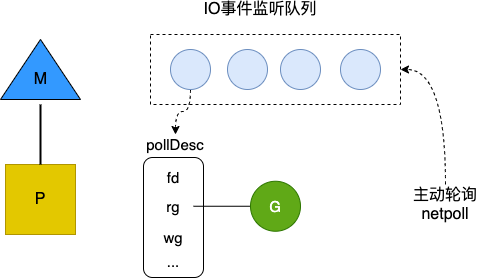
2.5.1 让出流程
pollDesc.waitRead() -> runtime.poll_runtime_pollWait() -> runtime.gopark()
-> mcall(fn func(*g)) -> park_m(gp *g)
gopark()主要流程
- 1)g切换到g0
- 2)修改G的状态 _Grunning -> _Gwaiting
- 3)dropg() 解除G和M的绑定关系
- 4)schedule() 触发一轮调度
2.5.2 放回 主动触发netpoll()
findrunnable()->netpoll()->injectglist()->globrunqputbatch()/runqputbatch()
pollWork()
startTheWorldWithSema
sysmon()
注意: netpoll函数是非阻塞的
2.6 定时器
time.Sleep(1 * time.Second)
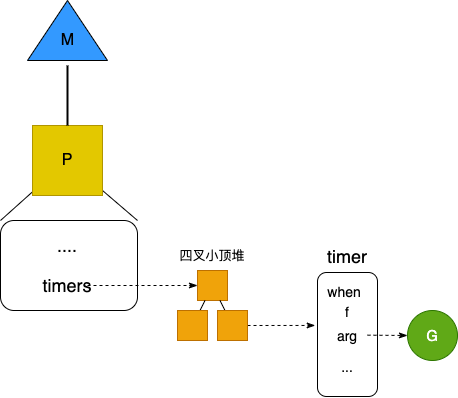
2.6.1 让出
time.Sleep() -> runtime.timeSleep() -> mcall() -> park_m()
-> resetForSleep() -> resettimer() -> doaddtimer()
2.6.2 唤醒
checkTimers() -> runtimer() -> runOneTimer() -> goready() -> systemstack() -> ready()
goready()主要流程
- 1)切换到g0的栈空间(不严谨)
- 2)修改Goroutine的状态 _Gwaiting -> _Grunnable
- 3)runqput() 把Goroutine放入P的本地队列的头部
- 4)如果M的数量不足,尝试创建一些M
注意: mcall()和systemstack()是对应的
2.7 Channel
ch := make(chan int)
ch <- 15
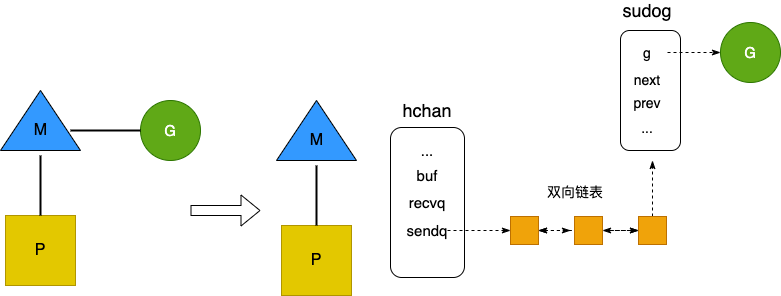
2.7.1 写入channel并阻塞
chansend1() -> chansend() -> hchan.sendq.enqueue() -> gopark()
2.7.2 就绪
chanrecv1() -> chanrecv() -> hchan.sendq.dequeue() -> recv() -> goready()
2.8 同步原语
互斥锁与2.6、2.7的情况非常类似,只是G会存储在Treap中
- Treap是一种平衡二叉查找树
- semaRoot 是全局唯一的
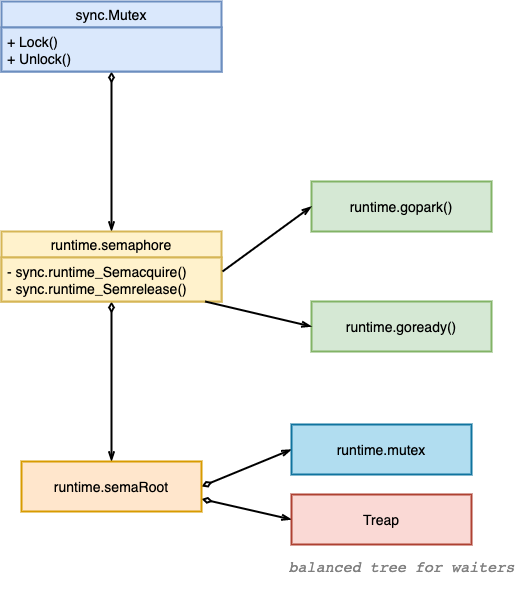
3.参考资料
1.g0-特殊的goroutine
2.golang syscall原理
3.Linux中的EAGAIN含义
4.Golang-gopark函数和goready函数原理分析
5.幼麟实验室-协程让出、抢占、监控和调度
6.Golang 调度器 GMP 原理与调度全分析
7.time.Sleep(1) 后发生了什么
8.mcall systemstack等汇编函数
请我喝瓶饮料

Recommend
About Joyk
Aggregate valuable and interesting links.
Joyk means Joy of geeK